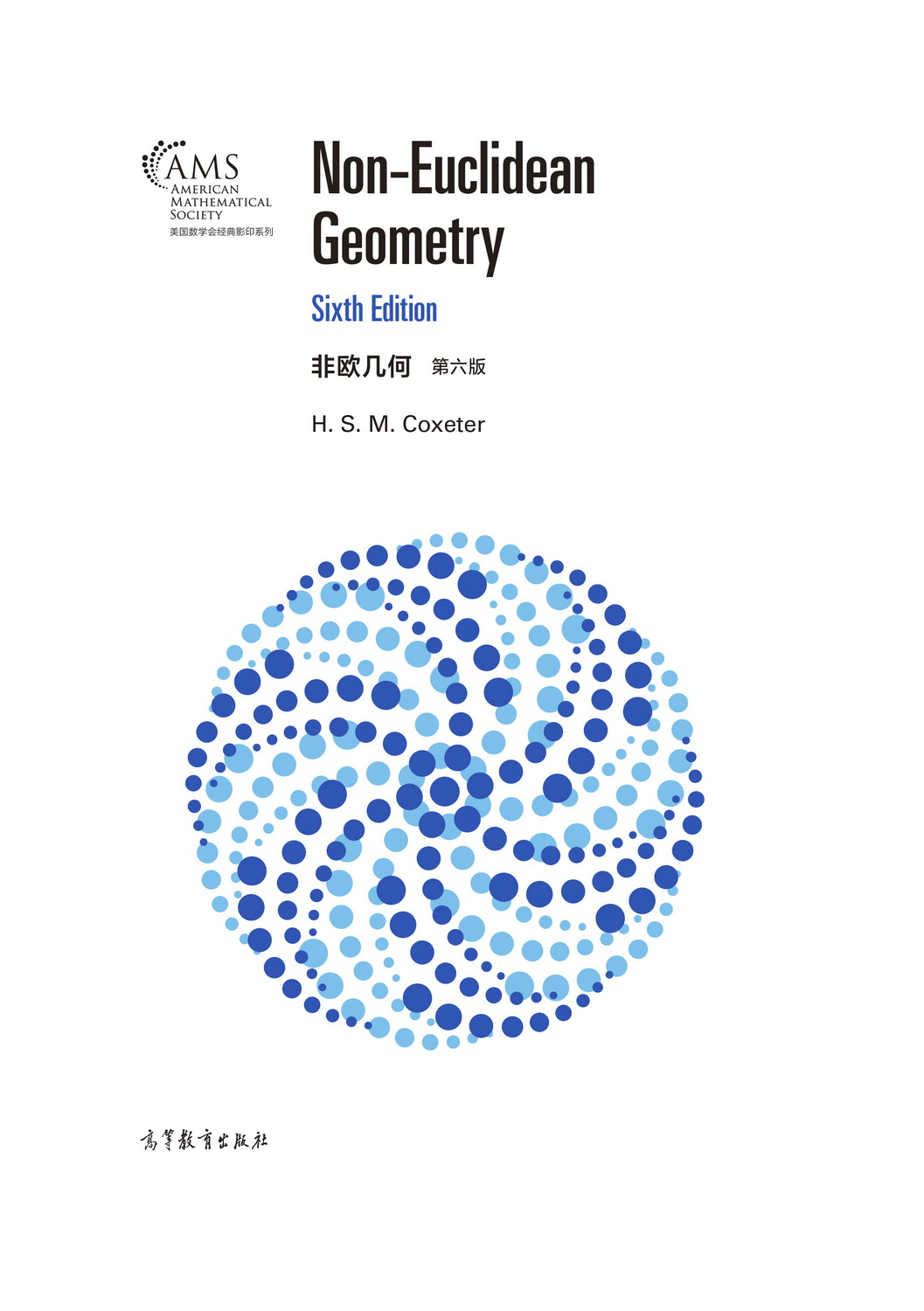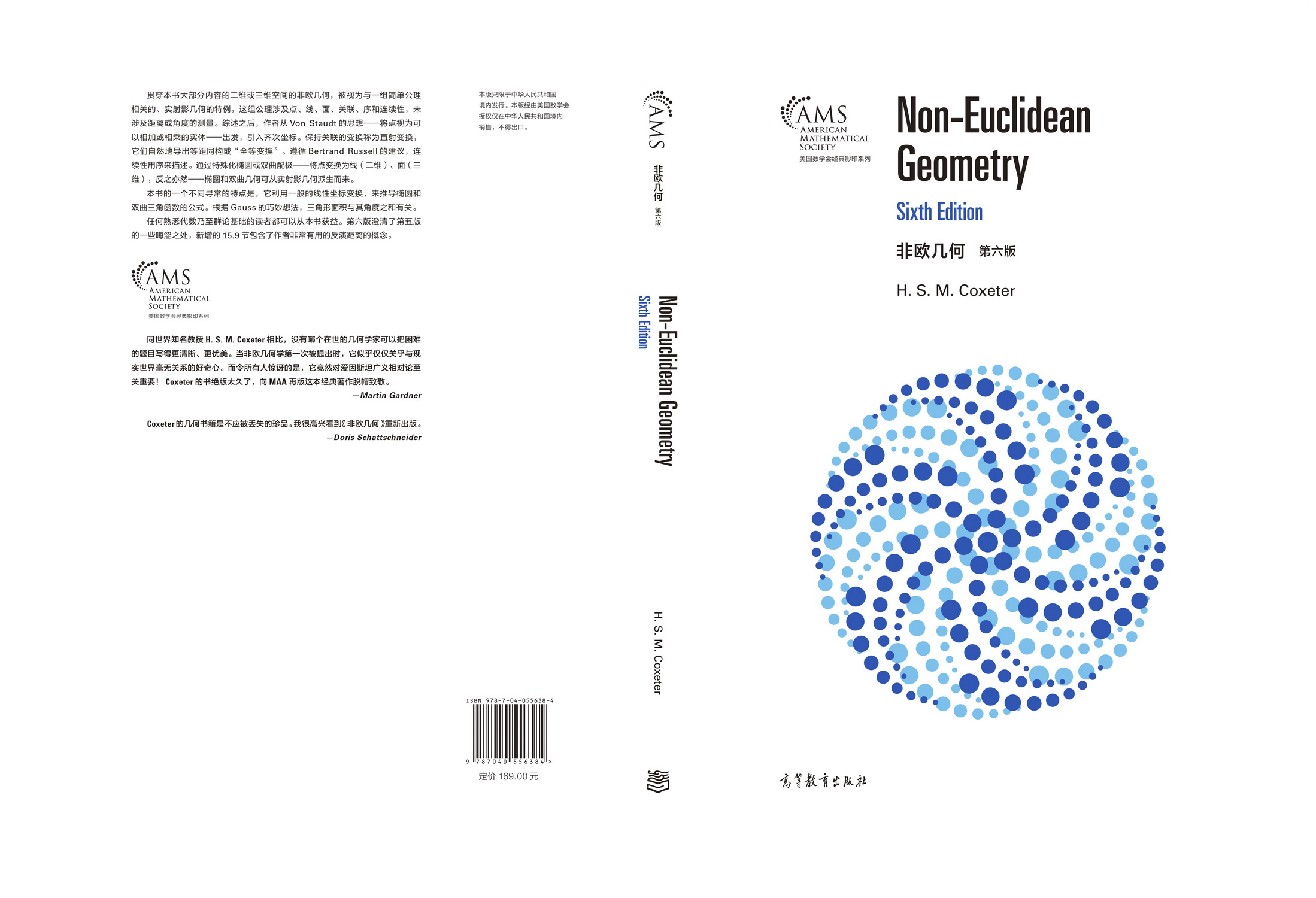非欧几何(第六版)(影印版)
作者: H.S.M.Coxeter
出版时间:2021-03
出版社:高等教育出版社
- 高等教育出版社
- 9787040556384
- 6版
- 369855
- 48265782-2
- 精装
- 16开
- 2021-03
- 576
- 360
- 理学
- 数学类
- 数学类
- 研究生及以上
前辅文
I. THE HISTORICAL DEVELOPMENT OF NON-EUCLIDEAN GEOMETRY SECTION PAGE
1.1 Euclid
1.2 Saccheri and Lambert
1.3 Gauss, Wächter, Schweikart, Taurinus
1.4 Lobatschewsky
1.5 Bolyai
1.6 Riemann
1.7 Klein
II. REAL PROJECTIVE GEOMETRY: FOUNDATIONS
2.1 Definitions and axioms
2.2 Models
2.3 The principle of duality
2.4 Harmonic sets
2.5 Sense
2.6 Triangular and tetrahedral regions
2.7 Ordered correspondences
2.8 One-dimensional projectivities
2.9 Involutions
III. REAL PROJECTIVE GEOMETRY: POLARITIES, CONICS AND QUADRICS
3.1 Two-dimensional projectivities
3.2 Polarities in the plane
3.3 Conies
3.4 Projectivities on a conic
3.5 The fixed points of a collineation
3.6 Cones and reguli
3.7 Three-dimensional projectivities
3.8 Polarities in space
IV. HOMOGENEOUS COORDINATES
4.1 The von Staudt-Hessenberg calculus of points
4.2 One-dimensional projectivities
4.3 Coordinates in one and two dimensions
4.4 Collineations and coordinate transformations
4.5 Polarities
4.6 Coordinates in three dimensions
4.7 Three-dimensional projectivities
4.8 Line coordinates for the generators of a quadric
4.9 Complex projective geometry
V. ELLIPTIC GEOMETRY IN ONE DIMENSION
5.1 Elliptic geometry in general
5.2 Models
5.3 Reflections and translations
5.4 Congruence
5.5 Continuous translation
5.6 The length of a segment
5.7 Distance in terms of cross ratio
5.8 Alternative treatment using the complex line
VI. ELLIPTIC GEOMETRY IN TWO DIMENSIONS
6.1 Spherical and elliptic geometry
6.2 Reflection
6.3 Rotations and angles Ill
6.4 Congruence
6.5 Circles
6.6 Composition of rotations
6.7 Formulae for distance and angle
6.8 Rotations and quaternions
6.9 Alternative treatment using the complex plane
VII. ELLIPTIC GEOMETRY IN THREE DIMENSIONS
7.1 Congruent transformations
7.2 Clifford parallels
7.3 The Stephanos-Cartan representation of rotations by points
7.4 Right translations and left translations
7.5 Right parallels and left parallels
7.6 Study's representation of lines by pairs of points
7.7 Clifford translations and quaternions
7.8 Study's coordinates for a line
7.9 Complex space
VIII. DESCRIPTIVE GEOMETRY
8.1 Klein's projective model for hyperbolic geometry
8.2 Geometry in a convex region
8.3 Veblen's axioms of order
8.4 Order in a pencil
8.5 The geometry of lines and planes through a fixed point
8.6 Generalized bundles and pencils
8.7 Ideal points and lines
8.8 Verifying the projective axioms
8.9 Parallelism
IX. EUCLIDEAN AND HYPERBOLIC GEOMETRY
9.1 The introduction of congruence
9.2 Perpendicular lines and planes
9.3 Improper bundles and pencils
9.4 The absolute polarity
9.5 The Euclidean case
9.6 The hyperbolic case
9.7 The Absolute
9.8 The geometry of a bundle
X. HYPERBOLIC GEOMETRY IN TWO DIMENSIONS
10.1 Ideal elements
10.2 Angle-bisectors
10.3 Congruent transformations
10.4 Some famous constructions
10.5 An alternative expression for distance
10.6 The angle of parallelism
10.7 Distance and angle in terms of poles and polars
10.8 Canonical coordinates
10.9 Euclidean geometry as a limiting case
XI. CIRCLES AND TRIANGLES
11.1 Various definitions for a circle
11.2 The circle as a special conic
11.3 Spheres
11.4 The in- and ex-circles of a triangle
11.5 The circum-circles and centroids
11.6 The polar triangle and the orthocentre
XII. THE USE OF A GENERAL TRIANGLE OF REFERENCE
12.1 Formulae for distance and angle
12.2 The general circle
12.3 Tangential equations
12.4 Circum-circles and centroids
12.5 In- and ex-circles
12.6 The orthocentre
12.7 Elliptic trigonometry
12.8 The radii
12.9 Hyperbolic trigonometry
XIII. AREA
13.1 Equivalent regions
13.2 The choice of a unit
13.3 The area of a triangle in elliptic geometry
13.4 Area in hyperbolic geometry
13.5 The extension to three dimensions
13.6 The differential of distance
13.7 Arcs and areas of circles
13.8 Two surfaces which can be developed on the Euclidean plane
XIV. EUCLIDEAN MODELS
14.1 The meaning of "elliptic" and "hyperbolic"
14.2 Beltrami's model
14.3 The differential of distance
14.4 Gnomonic projection
14.5 Development on surfaces of constant curvature
14.6 Klein's conformai model of the elliptic plane
14.7 Klein's conformai model of the hyperbolic plane
14.8 Poincaré's model of the hyperbolic plane
14.9 Conformai models of non-Euclidean space
XV. CONCLUDING REMARKS
15.1 HjelmsleVs mid-line
15.2 The Napier chain
15.3 The Engel chain
15.4 Normalized canonical coordinates
15.5 Curvature
15.6 Quadratic forms
15.7 The volume of a tetrahedron
15.8 A brief historical survey of construction problems
15.9 Inversive distance and the angle of parallelism
APPENDIX: ANGLES AND ARCS IN THE HYPERBOLIC PLANE
BIBLIOGRAPHY
INDEX











